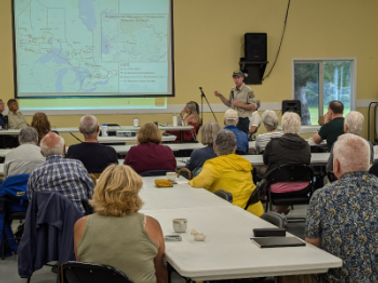
KLCA Projects

In April 2025, the KLCA began working through an exercise to develop and confirm a refreshed vision for the Kawagama & Bear Lakes community to meet the needs of the community over the next 20 years. Our goal is to gather community input in the creation of a new strategic plan for the KLCA to support that vision.
KLCA Projects

As part of our commitment to monitor and work to protect the health of our lakes, the KLCA is excited to announce that we are participating in a project to gather valuable data about the robustness of our lake ecosystem.
This project involved the consolidation of past research (a literature review) to understand the reasons behind calcium loss in freshwater lakes (specifically Kawagama Lake), and the impacts of this decline on aquatic life, in addition to recommendations for action that can be taken to reduce this decrease.

BENTHIC BIOMONITORING PROJECT
As part of our commitment to monitor and work to protect the health of our lakes, the KLCA is participating in a project to gather valuable data about the robustness of our lake ecosystem. Kawagama and Bear Lakes were selected as part of only six lakes to be included in the project. Students from Trent University have taken on the data collection and analysis.
Read more about the project and the latest results here: Benthic Invertebrate Monitoring 2023.
PROJECT RESULTS
2020 Kawagama Lake and Bear Lake Final Report
BIOMONITORING FAQ
What is biomonitoring?
Biomonitoring samples benthic macro-invertebrates to measure lake health.
What are benthic macro-invertebrates?
Benthic macro-invertebrates are aquatic "bugs" that live on the bottom of a stream, river or lake. Aquatic worms, insects and crustaceans make up the bulk of our benthic macro-invertebrate samples.
Why do we monitor benthic macro-invertebrates?
Conventional water quality sampling consists of sampling at a specific point in time, that few minutes that it takes to collect a sample. Although this sampling provides great information for the specific time sampled, it does not necessarily tell us what is happening in the lake over the remainder of the year.
Benthic invertebrates live in a lake for up to three years. During this time, they are exposed to the full range of water quality conditions present in the lake. Some species require excellent water quality to survive while others are quite tolerant of pollution. By looking at the different species present at a sampling site, we can identify whether lake health is good, fair or poor.
Monitoring of benthic invertebrates allows us to answer several important questions: “Is development impacting lake health?” “Are our lakes becoming healthier or more degraded over time?” “Where will our stewardship activities be most effective?” “Are our stewardship activities resulting in water quality improvements?”

CALCIUM DECLINE PROJECT
U-LINKS & TRENT UNIVERSITY PROJECT - CALCIUM DECLINE
A three-member team from Trent University have completed their project that focused on calcium decline, impacts and potential mitigation efforts for Kawagama Lake.
Calcium has been declining in Kawagama Lake due to historic and ongoing acid deposition. These declining calcium levels can have a negative impact on the aquatic food-chain and can thus affect the growth of various sport fish.
The project involved the consolidation of past research (a literature review) to understand the reasons behind this calcium loss in freshwater lakes (specifically Kawagama Lake), and the impacts of this decline on aquatic life, in addition to recommendations for action that can be taken to reduce this decrease.
The following are links to the results of the calcium decline project completed by students from Trent University

.jpeg)

CALCIUM DECLINE PROJECT 2
This research is concerned with assessing the present state of calcium pools in the Kawagama Lake watershed in Haliburton county, Ontario
This information is intended to guide future decisions regarding mitigation and further research
Soil samples were collected from six sites along the north shore of the Kawagama
Calcium Concentration (meq/100g Soil) Calcium Concentration (mg/g) Magnesium Concentration (mg/g) Potassium Concentration (mg/g) Lake watershed. Each sample was comprised of four soil horizons: L (litter), FH (fibric and humus), A (upper mineral soil), and B (lower mineral soil)
The samples from each horizon at the six sites were tested for their pH level, percent of organic matter, and exchangeable base cations (including calcium, magnesium, and potassium)
U-LINKS & TRENT UNIVERSITY PROJECT - CALCIUM DECLINE 2
PROJECT RESULTS




